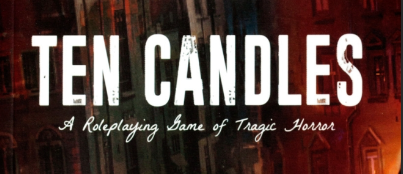-candles represent sanity -characters all lose their sanity and must roleplay there specific phobia as the candles go out -Vice is replaced with a form of insanity -Virtue is replaced with a bond / relationship -Moment and brink remain as standard rules
Discuss among yourselves…


This may only be an opinion I have but often I feel that narrative in RPGs is actually two slightly more distinct styles; I’ll call them immersive and performative, but I presume somebody else has already named them.
I think 10 candles is one of the few systems that sets it’s sights on immersive narrative play. This is, imo, the hardest thing to pull off in any TTRPG and I envy eny player who can reach this style easily. 10 candles may make you actually afraid and feel hopeless in a way few other games can.
Madness in my opinion is a performative narrative mechanic. As a player you don’t feel compelled to act mad in their own fear, but are responding to a mechanic to continue to set the tone. Gumshoe in general and F.A.T.E too for that matter are top of the class for narrative TTRPGs, but they target the performative side.
I first came across this when I was playing D&D and could recognise that all my players preferred roleplaying to anything else, but when we tried F.A.T.E, it didn’t gel with two of them. We’d been falling into a common pattern which was three of us would basically perform to create the immersive experience for the remaining two, in the process all getting what we all wanted. This only worked because the 5e narrative mechanics are basically three skills that are only called for at the DM’s discretion, which was then being called for less for the immersed players in favour of actually just weighing their arguements. Then in F.A.T.E and gumshoe, the additional guidance for roleplay actually locks players into performative pkay.
There isn’t too much in 10 candles that actually disrupts the immersive style of roleplay. Anything that is properly introduced as “who your character is” rather than “what your character is doing” can support this style of play, and is particularly strong for prompts introduced in the character creation stage. These prompts should also be few and far between, so they never limit natural choices and bring the character out of immersion. I just don’t know if madness can do that.
That’s all my opinion, I’m not a game designer beyond GMing my own systems, and I may be totally wrong.
All of this said, I do think my biggest issue with ten candles is that when the game is down to one candle, the tone change from “the tragic tale of the hopeless acts of humanity in an inevitably ending world” to “everyone gets killed off one by one”, is solved by making the ticking clock madness.
The actual game sort of treats the ticking clock as your resolve to keep going, but that would make the final failure the moment your resolve fails and you simply give in. In reality, people often don’t want to go down without a fight, so everyone’s resolve flairs up at the end, just to be defeated anyway.
Madness is a more accurate mechanic for ticking towards everything going wrong, because it’s expected to end dramatically. The extinguishing of candles feels more like a fuse in this situation, and when it all cumulates at the end of the game, that’s the foreshadowed tonal shift being met.
Again my opinions are absolutely that of an amateur and god knows why I wrote so much about this.